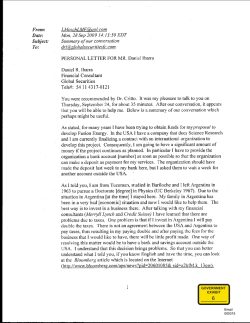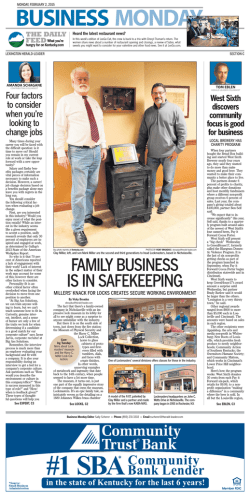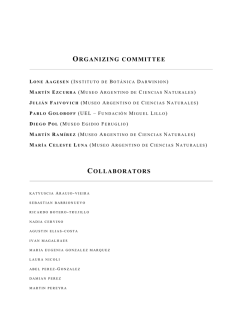
maximum age and provenance area of the puncoviscana fm
TOMO 1 - Análisis de Cuencas MAXIMUM AGE AND PROVENANCE AREA OF THE PUNCOVISCANA FM. SEDIMENTS (NW ARGENTINA) BASED ON DETRITAL ZIRCON GEOCHRONOLOGY A PILOT STUDY Ch. Adams, GNS Science, Lower Hutt, [email protected] Hubert Miller, Ludwig-Maximilians-Universität München, [email protected] Alejandro J. Toselli, Universidad Nacional de Tucumán, [email protected] The Puncoviscana Formation covers great areas in NW Argentina (Fig. 1). Age and paleogeographic relations of the mostly turbiditic anchimetamorphic sedimentary rocks have been widely discussed in the past (Aceñolaza & Miller 1982, Omarini et al. 1999). Type and style of the deposition and provenance areas of the sediments have been considered in comprehensive papers by petrological (Omarini 1983, Ježek & Miller 1987) and geochemical studies (Willner et al. 1990, Zimmermann 2005). Fig.1. Outcrop map and sample site at Quebrada del Toro, NW Argentina. " 11 XI CONGRESO GEOLOGICO CHILENO Ježek & Miller (1987) assumed high tectonic levels of intracontinental orogenic belts in the interior of the Brazilian Shield to be the main sources of the rocks and their higher-grade metamorphic equivalents, and an inactive continental margin setting along the Pacific edge of Gondwana for the deposition site. Willner et al. (1990) supposed poorly reworked sediments at the provenance area and deposition at a fairly stable continental margin. Zimmermann (2005) interprets the Puncoviscana trough as a peripheral Pampean foreland-basin, fed mainly from a nearby eastern fold-thrust belt of upper continental crust model composition, cannibalistically reworked into the same basin and transported only a short distance. Trace fossil assemblages demonstrate an early Cambrian age for most of the sedimentary parts of the formation (Durand & Aceñolaza 1990), while Rb-Sr data on equivalents of higher metamorphic grade are partly older and point to an uppermost Neoproterozoic deposition age (e.g. Bachmann et al. 1986). First attempts to define the maximum age of the Puncoviscana Fm. by conventional analyses of detrital zircon U-Pb age populations from non-metamorphic or only weakly metamorphosed rocks pointed to Mid Cambrian ages for the youngest, euhedral, almost concordant grains found (Lork et al. 1990). LA ICP MS U-Pb single zircon dating has now begun on samples of the Puncoviscana Fm. Sample QT4 comes from the Quebrada del Toro, a classic site for the Puncoviscana formation due to an early Cambrian trace fauna (Durand & Aceñolaza 1990). The age spectrum comprises minor peaks of early to mid-Proterozoic ages and two significant zircon age maxima of 860 to 1100 Ma and 580 to 760 Ma (Fig. 2). Schwartz & Gromet (2004) found nearly identical zircon age patterns on metamorphic rocks of the Sierras de Córdoba, which may be considered temporal and paleogeographic equivalents of the Puncoviscana Fm. The zircons ages around 1000 Ma are easily explained by provenance from Mesoproterozoic orogens of the Brazilian Shield (Tassinari et al. 2000) although relations to Laurentia (Grenville orogeny) cannot be excluded. The provenance of the youngest data peak shows clearly no relation to Laurentia. However, they exactly coincide with the “Fase Puníllica” (600-750 Ma) from the Eastern Pampean Ranges, forming part of the “Ciclo Limayeano” defined by Linares et al. (2002). Dardenne (2000) mentioned similar ages as “early Brazilian” from Brazil. 12 " TOMO 1 - Análisis de Cuencas Fig. 2. Age maxima of detrital zircons of sample QT4 Zimmermann’s (2005) supposition of reworking of an adjacent or subjacent orogenic belt feeding the Puncoviscana through could be an explanation for the 580 to 760 Ma ages. On the other hand, this assumption does not explain the frequent 860 to 1100 Ma ages and still less the older ones. The existence of zircons of both ages is compatible with the generally westerly transport direction within the trough (Ježek & Miller 1987), and argues in favor of an autochthonous position for the Pampia and Córdoba terranes. REFERENCES Aceñolaza, F.G.: Miller, H. 1982. Early Palaeozoic orogeny in southern South America. Precambrian Research, Vol. 17: 133-146. Bachmann, G.; Grauert, B.; Miller, H. 1986: Isotopic dating of polymetamorphic meta-sediments from NW-Argentina. Zentralblatt für Geologie und Paläontologie. Teil I, Vol. 1985: 1257 - 1268. Dardenne, M.A. 2000. The Brasilia Fold Belt. In Tectonic Evolution of South America (Cordani, U.G.; Milani, E.J.; Thomaz Filho, A.; Campos D.A. eds.). 31th International Geological Congress 2000 Rio de Janeiro, p. 231-263. Rio de Janeiro. Durand, F.R.; Aceñolaza, F.G. 1990. Caracteres biofaunísticos, paleoecológicos y paleogeográficos de la Formación Puncoviscana (Precámbrico Superior - Cámbrico Inferior) del Noroeste Argentino. In El Ciclo Pampeano " 13 XI CONGRESO GEOLOGICO CHILENO en el Noroeste Argentino (Aceñolaza, F.G.; Miller, H.; Toselli, A.J. eds.). Serie Corre-lación Geológica, Vol. 4: p.71-112. Tucumán. Ježek, P.; Miller, H. 1987. Petrology and facies analysis of turbiditic sedimentary rocks of the Puncoviscana trough (Upper Precambrian - Lower Cambrian) in the basement of the NW Argentine Andes. In Gondwana Six: Structure, Tectonics, and Geophysics (McKenzie, G.D.; ed.). Geophysical Monograph Vol. 40, p. 287 - 293. Washington, D.C. Linares, E.; Haller, M.J.; Ostera, H.A. 2002: Los ciclos magmáticos de la República Argentina: Revi-sión sobre la base de las edades radimétricas al año 2000. In XV Congreso Geológico Argentino, Actas, CD-ROM, Artículo N° 051, 11 pp. El Calafate, Argentina. Lork, A.; Miller, H.; Kramm, U.; Grauert, B. 1990. Sistemática U-Pb de circones detríticos de la Fm. Puncoviscana y su significado para la edad maxima de sedimentación en la Sierra de Cachi (prov. de Salta, Argentina). In El Ciclo Pampeano en el Noroeste Argentino (Aceñolaza, F.G.; Miller, H.; Toselli A.J.; eds.). Serie Correlación Geológica, Vol. 4, p. 199-208. Tucumán. Omarini, R.J. 1983. Caracterización litológica, diferenciación y génesis de la Formación Punco-viscana entre el Valle de Lerma y La Faja Eruptiva de la Puna., Tesis de Doctorado (Inédito), Universidad Nacional de Salta, 202 p. Omarini, R.J.; Sureda, R.J.; Götze, H.J.; Seilacher, A.; Pflüger, F. 1999. Puncoviscana folded belt in the northwestern Argentina: testimony of Late Proterozoic Rodinia fragmentation and pre-Gondwanic collisonal episode. International Journal of Earth Sciences, Vol. 88: 76-97. Schwartz, J.J.; Gromet, L.P. 2004. Provenance of a late Proterozoic - Early Cambrian basin, Sierras de Córdoba, Argentina. Precambrian Research, Vol. 129: 1-21. Tassinari, C.G.; Bettencourt, J.S.; Geraldes, M.C.; Macambira, M.J.B.; Lafon, J.M. 2000. The Amazonian Craton. In Tectonic Evolution of South America. (Cordani, U.G.; Milani, E.J.; Thomaz Filho, A.; Campos D.A.; eds.). 31th International Geological Congress, p. 41-95. Rio de Janeiro. Willner, A.P.; Miller, H.; Ježek, P. 1990. Composición geoquímica del basamento sedimen-tario/metamórfico de los Andes del NW Argentino (Precámbrico Superior/Cámbrico Inferior). In: El ciclo Pampeano en el Noroeste Argentino (Aceñolaza, F.G.; Miller, H.; Toselli A.J.; eds.). Serie Correla-ción Geológica, Vol. 4, p.161179. Tucumán. Zimmermann, U. 2005. Provenance studies of very low- to low-grade metasedimentary rocks of the Puncoviscana complex, northwest Argentina. In Terrane processes at the margins of Gondwana (Vaughan, A.P.M.; Leat, P.T.; Pankhurst, R.J.; eds.). Geological Society of London, Special Publications, Vol. 246: p. 381416. London. 14 "
© Copyright 2026






